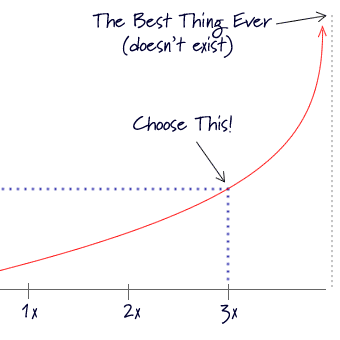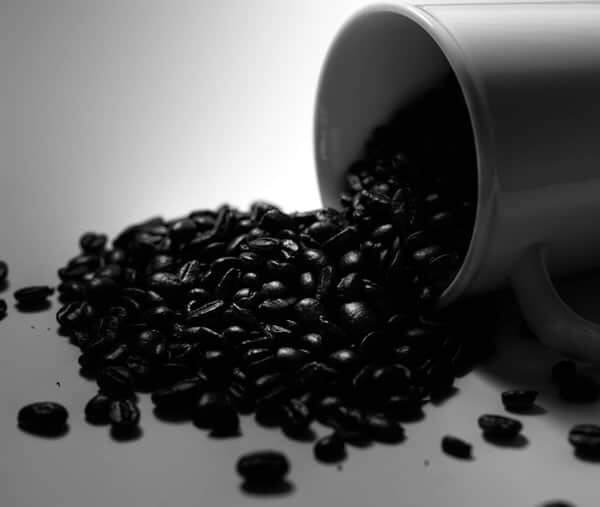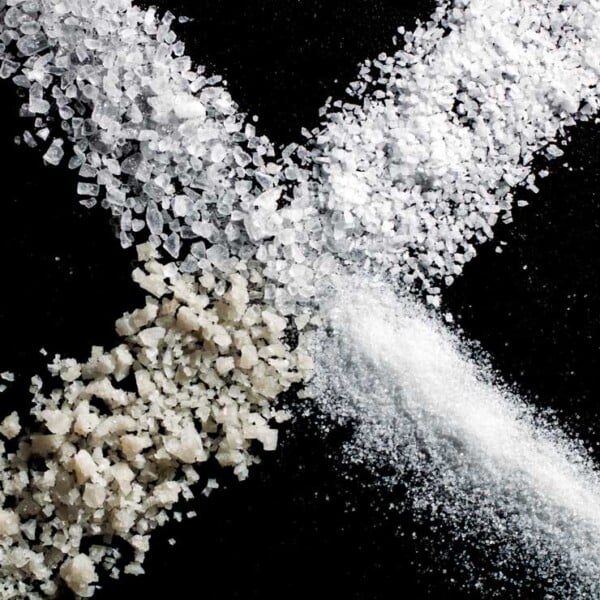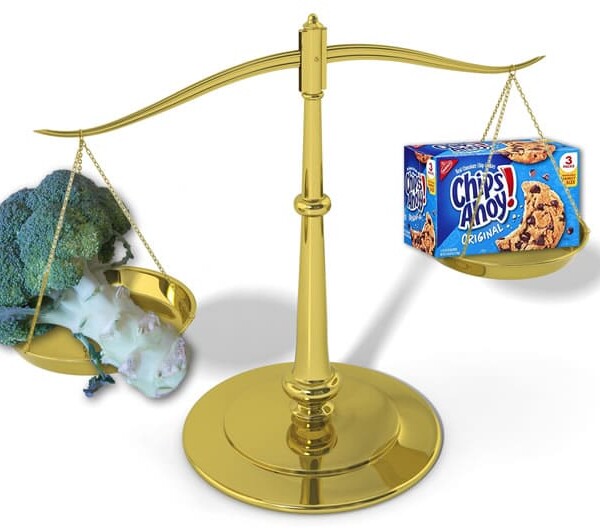There are no bad foods (and five more industry lies)
Apr 14, 2017, Updated Sep 26, 2018
Spin, Spin, Spin…
Over the past few years, I’ve been bumping into the same arguments over and over again about food and healthful eating. They are pervasive and persuasive, and pretty convincing if you aren’t willing to scratch below the surface. But if you really stop to think about them, they’re specious arguments. Next time you hear any of these food-related claims, take a moment and think about what’s really going on.

1. “There are No Bad Foods.”
According to the food industry, there are no such thing as bad-for-you foods, it’s just how much of them you eat.
Bullpoo! Of course there are unhealthful foods!
The easiest example to give is anything with man-made trans fats (which is anything with hydrogenated or partially-hydrogenated oil). There is no safe intake level of trans fats. Some other simple examples: Chocolate Cake or Potato Chips (they may be good for you psychologically, but not physically). Or how about soda, which has absolutely no redeeming nutritional value?
(Okay, if you want to split hairs: Yes, the sugar will give you energy, but there’s no other nutritional benefit whatsoever — and the negative effects of soda and other sugar-sweetened beverages [PDF] are well-documented and well-known.)
Last month there was a study published in the New England Journal of Medicine that drives home this point. They learned that — surprise, surprise — potato chips are bad for you, while fresh fruits and veggies are good for you. Dr. Mozaffarian, one of the study’s authors, was quoted in the New York Times: “There are good foods and bad foods, and the advice should be to eat the good foods more and the bad foods less.” He continued: “The notion that it’s O.K. to eat everything in moderation is just an excuse to eat whatever you want.”
Which brings us to my next point.
2. “Everything in Moderation.”
Okay, so there are bad-for-you foods. But taken in moderation, they’re okay, right? Well, yes. But watch out, it’s not that simple.
The definition of “moderation” is very different than what the food industry would have you believe. Purveyors of processed products lure you in with the notion that you can indulge a little each day and be just fine. In theory, that’s true. In practice, however, it rarely works out that way.
The 2005 USDA Guidelines used the term “discretionary calories,” defining them as the extra, nutritionally-devoid calories you could safely consume (around 150 to 300 each day, depending on overall caloric needs), after you’ve already satisfied the rest of your day’s nutritional requirements. The more recent 2010 “My Plate” guidelines use the term “empty calories” (a phrase, I’m pretty sure, that was actually coined by my mother). Same concept, but now with a more accurate name. (“Discretionary” doesn’t have quite the same negative connotation as “empty” — so I think this is an improvement on the USDA’s part).
So if — and only if — you ate perfectly healthfully all day long (practically impossible), you could then indulge in just three Oreo Cookies or half an order of In-N-Out Fries, or one can of Coke. In reality though it just doesn’t work that way. Most of us sneak our empty calories into our mouths a little at a time, often without even realizing it (ketchup or mayonnaise on a sandwich, a teaspoon of sugar in our coffee, chips with our sandwich, Gatorade after a workout).
It’s not just the obvious, added bits, either. That 500-calorie bran muffin? Sure, 300 of those calories might come from good-for-you ingredients (like whole grains) — but the other 200 might come from discretionary/empty butter and sugar.
Those empty calories add up so quickly and easily that there’s actually no room left over for that cookie at the end of the day. As a result, a more appropriately reality is that most of us can indulge once a week, not once a day. Sure, have those Oreos, fries, or Coke. But do it once a week, not once a day, and when you do indulge, truly make it count. (Oh, and please make sure it’s just once a week — most of us underestimate how frequently we indulge! Don’t believe me? Keep a log.)
3. “Personal Responsibility.”
This is probably the most controversial of my pet peeves. I whole-heartedly believe that personal responsibility is incredibly important, and tops the list of improving one’s diet and health. You decide what you put in your mouth (or your kids’ mouths).
But that’s not the whole story.
There are dozens of factors that influence what you choose to eat. Taste is the primary factor, of course, and many people stop there (though if you’re reading this, you’re probably not one of those people). Food companies engineer their products in labs (not kitchens) to taste good, using the holy trinity of fat, sugar, and salt. Our brains are hard-wired to enjoy those three flavors/ingredients, and a good case can be made that they can actually be physically addictive. (For a terrific, and highly-readable, discussion of this particular topic, check out The End of Overeating by David Kessler.)
So when it comes to taste, we’re up against an industry that spends billions of dollars to formulate their products, taking advantage of our brain chemistry. It’s no secret, and it’s nothing new — but to imply that choosing what we eat is simply a matter of willpower, and nothing else, is a bit disingenuous.
So how about advertising? In 2010, Pepsico, the largest food and beverage company in the United States, spent $3.4 Billion on marketing and advertising.[1] That’s only about 10% of all food product advertising each year! Companies wouldn’t spend those incredible amounts of money unless, of course, advertising worked.
Other external factors come into play, as well. To name a few: Knowledge and education. Accurate information about what is actually in the food. Misleading or confusing labeling on packages (Nutritionism!). Cost, budget, and affordability. Availability and Food Deserts. Convenience. Time constraints. Peer pressure and social situations. Structural Racism (hat tip: Emily). (Want more? Check out this discussion on the Eating Rules Facebook Page).
I’ve said it before, and I”ll say it again: There needs to be a level playing field, and right now the odds are tipped far, far away from the consumer.
4. “Fruit Juice is Fruit.”
I can certainly understand why the food companies consider this lie to be true — it makes sugary beverages seem healthful, and that’s good for sales! Unfortunately, our government supports this ridiculous notion as well.
Fruit juice is essentially sugar-water –– with a few vitamins remaining. Whole fruit, however, still contains fiber and additional nutrients. This makes an enormous difference. Even if it’s the same amount of sugar, it’s absorbed by the body at a different rate. Additionally, real fruit will keep you feeling fuller longer, and therefore you’ll be likely to consume fewer overall calories that day.
One cup (8 ounces) of Apple Juice contains 114 calories, almost all of which come from 24 grams of sugar. It has 4% of your day’s Vitamin C, and 2% of your calcium and iron — numbers so low, they’re essentially irrelevant. Compare that to 8 ounces of Coke, which contains 100 calories and 27 grams of sugar. That means Coke and apple juice have a nearly identical nutritional profile.
In comparison, one large apple (3.25″ diameter) contains 116 calories, 23 grams of sugars, 17% of your Vitamin C, and 5 grams of fiber. That’s about 20% of your day’s fiber.
5. “Eating Healthfully is More Expensive.”
In the short term, if you consider only what you pay at the grocery store — this can certainly be true. Calorie-for-calorie, fresh fruits and vegetables cost up to ten times more than highly-processed food options.
Why? Because of government subsidies (which we desperately need to fix). Our government subsidizes corn production — the worst offender — at a rate of about $4 Billion a year. This artificially reduces the price, making corn an incredibly cheap commodity — which is then used for sweeteners, cheap livestock feed, and a whole host of other products. As David Sirota says in this must-read Salon piece, “That’s why McDonald’s can sell you a Big Mac, fries, and a Coke for around $5 — a bargain.”
In the long term, if you consider the cost savings of eating healthfully, then this industry lie becomes even more apparent. Obesity alone is estimated to have cost the United States $147 Billion in 2008. Obesity is just one part of it, of course. The USDA estimates that if we all ate more healthfully, we’d collectively save $71 Billion a year.
6. “Natural.”
I’ve written about this before, but it bears repeating. When it comes to food marketing, the term “Natural” is completely unregulated and is effectively meaningless.
I’ve seen “All Natural” claims on products that contain high fructose corn syrup, preservatives, artificial colors and flavors, and all sorts of other additives that I can’t even pronounce — none of which would I consider “natural.”
What’s most frustrating is that even though I know this to be true, I still catch myself falling for it every once in awhile. The word “natural” is so loaded, so powerful, that it’s hard, perhaps impossible, to break out of that mindset. The best solution? If you see “natural,” be incredibly skeptical.
And remember, if a product has to make health claims, it’s probably not a healthy product.
—
[1] “Snacks For a Fat Planet” by John Seabrook. The New Yorker, May 16, 2011.
Photo by Paco CT.





















The food industry is leading toward many false claims, the words “organic” or “natural” are just used to increase the sales and nothing else, and the consumer does believe this so called organic stuff and pay as much as they are asked to. Nice post, Andrew, you should write such reality-based information more.
I just wanted to chime in on the ’empty-ness’ of butter. I have experience with it because I had a test done a while back that showed my gut needed a fat called butyrate, which can only be found in butter! At the time, I was eating NO butter, and once I added it in, my digestion was much better (still is). Loved this article though, Andrew, it’s fun to read your thoughts!
We all think we are experts in three areas, breathing, sex and food. My commitment is eat so I can keep breathing and having sex. I plan to eat myself into old age like the oldest man ever on record, Jiroemon Kimura, who passed away in 2011 at the age of 116. The way people of Kimura’s home in the Okinawa Islands of Japan eat allows them to enjoy exceptionally long lives. I emphasize enjoy because in addition to adding years to their lives, they retain their youthful exuberance, independence and vitality as long as they live. Another group of people who enjoy longer life expectancy are the residents of the San Blas islands off the coast of Panama. They rarely suffer from high blood pressure, cancer and heart disease. The common denominator: both groups typically nourish themselves the 70-15-15 way: •70% of calories come from plant-based foods: fruits, vegetables… Read more »
“There are no bad foods … only bad diets” – decode this and it says “there are no bad foods until you eat them, because then they’re in your diet, and then its your fault because your diet is your own responsibilty, not ours.”
Preposterous, insane, CokeSpeak!
(says Alice)